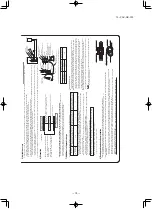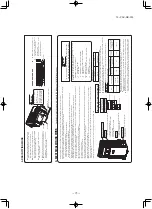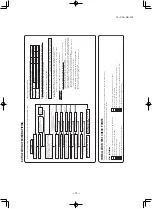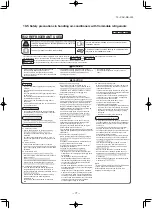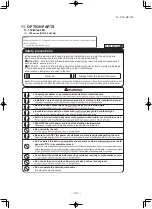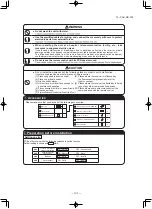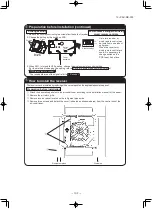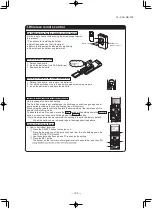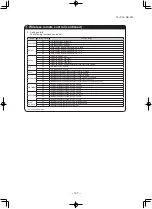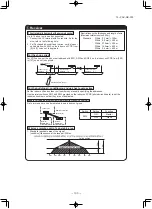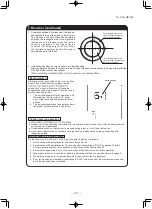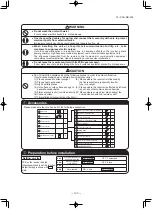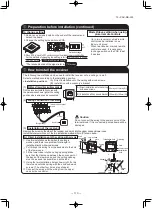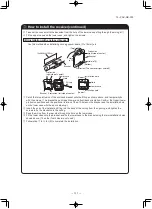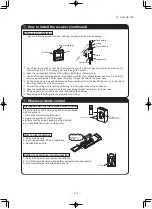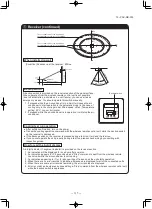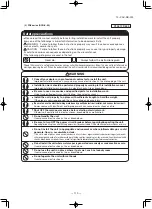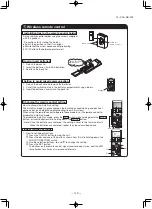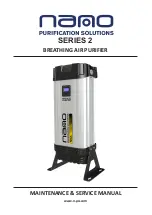
'19 • PAC-DB-333
To change setting
1. Remove one screws located on the under of the receiver and
detach the board.
2. Change the setting by the switch on PCB.
3. When SW1 is turned to OFF position, change the wireless remote control setting.
For the method of changing the setting, refer to Setting to avoid mixed
communication of
④
Wireless remote control
.
*The receivable area of the signal refer to
⑤
Receiver
.
Default settings
WARNING
WARNING
Safety precautions
①
Accessories
●
Please read this manual carefully before starting installation work to install the unit properly.
Every one of the followings is important information to be observed strictly.
WARNING Failure to follow these instructions properly may result in serious consequences
such as death, severe injury, etc.
CAUTION Failure to follow these instructions properly may cause injury or property damage.
It could have serious consequences depending on the circumstances.
●
The following pictograms are used in the text.
Never do.
Always follow the instructions given.
●
Keep this manual at a safe place where you can consult with whenever necessary. Show this manual to installers when
moving or repairing the unit. When the ownership of the unit is transferred, this manual should be given to a new owner.
●
Consult your dealer or a professional contractor to install the unit.
Improper installation made on your own may cause electric shocks, fire or dropping of the unit.
●
Installation work should be performed properly according to this installation manual.
Improper installation work may result in electric shocks, fire or break-down.
●
Be sure to use accessories and
specified
parts for installation work.
Use of unspeci
fied parts may result in drop, fire or electric shocks.
●
Install the unit properly to a place with
sufficient
strength to hold the weight.
If the place is not strong enough, the unit may drop and cause injury.
●
Be sure to have the electrical wiring work done by
qualified
electrical installer, and use exclusive circuit.
Power source with insufficient and improper work can cause electric shock and fire.
●
Shut OFF the main power source before starting electrical work.
Otherwise, it could result in electric
shocks, break-down or malfunction.
●
Do not modify the unit.
It could cause electric shocks, fire, or break-down.
●
Be sure to turn OFF the power circuit breaker before repairing/inspecting the unit.
Repairing/inspecting the unit with the power circuit breaker turned ON could cause electric shocks or injury.
●
Do not install the unit in appropriate environment or where
inflammable
gas could
generate,
flow
in, accumulate or leak.
If the unit is used at places where air contains dense oil mist, steam, organic solvent vapor, corrosive gas (ammonium,
sulfuric compound, acid, etc) or where acidic or alkaline solution, special spray, etc. are used, it could cause electric
shocks, break-down, smoke or fire as a result of significant dete
rioration of its performance or corrosion.
●
Do not install the unit where water vapor is generated excessively or condensation occurs.
It could cause electric shocks, fire, or break-down.
●
Do not use the unit in a place where it gets wet, such as laundry room.
It could cause electric shocks, fire, or break-down.
●
Do not operate the unit with wet hands.
It could cause electric shocks.
●
Do not wash the unit with water.
It could cause electric shocks, fire, or break-down.
●
Use the
specified
cables for wiring, and connect them securely with care to protect
electronic parts from external forces.
Improper connec
tions or fixing could cause heat generation, fire, etc.
●
When installing the unit at a hospital, telecommunication facility, etc., take
measures to suppress electric noises.
It could cause malfunction or break
-
down due to hazardous effects on the inverter, private
power generator, high frequency medical equipment, radio communication equipment, etc.
The influences transmitted from the remote control to medical or communication equipment
could disrupt medical activities, video broadcasting or cause noise interference.
●
Do not leave the remote control with its PCB case removed.
If dew, water, insect, etc. enters through the hole, it could cause electric
shocks, fire or break-down.
CAUTION
Please make sure that you have all of the following accessories.
②
Preparation before installation (continued)
②
Preparation before installation
Setting on site
PCB on the receiver has the
following switches to set the function.
Default setting is shown with
mark.
Up to two receiver or wired remote
control can be installed in one
indoor unit group.
When two receiver or wired remote
control are used, it is necessary
to change switch on the PCB to set
it as slave.
③
How to install the receiver
③
How to install the receiver(continued)
The following two methods can be used to install the receiver onto a ceiling or a wall.
Select a method according to the installation position.
<Installation position>
(A) Direct installation onto the ceiling with wood screws.
(B) Installation with accessory's bracket
⑤
Take out the connector to the backside from the hole of the lower case putting through the wiring at
①
.
⑥
Fit the upper case and the lower case, and tighten the screws.
Use this method when installaing onto a gypsum board (7 to 18mm), etc.
①
Catch the two protrusion of the enclosed bracket onto the
fi
tting as shown above, and temporarily
fi
x
with the screws. (The bracket has an Upper/Lower and front/back orientation. Con
fi
rm the Upper/Lower
protrusion positions and the positional relation of the ø10 holes on the bracket and the installation hole
on the lower case with the above drawing.)
②
Insert the end of the installation
fi
tting into the back of the ceiling from the opening, and tighten the
screws to
fi
x the bracket onto the ceiling.
③
Pass the wiring from the rear side through the hole on the lower case.
④
Fit the lower case onto the bracket, and
fi
x the lower case to the bracket using the two installation holes
shown above. (The other four holes are not used.)
⑤
Follow step
①
to
⑥
for (A) to complete the installation.
Caution
Do not connect the wiring to the power source of the
terminal block. If it is connected, printed board will be
damaged.
1
3
4
2
Drill the receiver installation holes with
the dimensions shown right at the ceiling
position where wires can be connected.
(A) Direct installation onto the ceiling
with wood screws.
88mm(H)×101mm(W)
(B) Installation with enclosed bracket
108mm(H)×108mm(W)
(1)
Drilling of the ceiling (ceiling opening)
(2)
Wiring connection of receiver
Wiring
Indoor unit terminal
block
(No polarity)
Reciever
Remove the screw on the side of the receiver and sprit it into the upper case and lower case.
Install the receiver with one of the two installation methods (A) to (C) shown below.
△
Use this installation method when the ceiling is
wooden, and there is no problem for strength in
installing directly with wood screws.
①
Put through the wiring from the back side to the hole
of the lower case.
②
Fit the lower case into the ceiling opening. Make
sure that the clearance between the convex part of
the back of the lower case and the ceiling opening
must be as equal as possible on both sides.
③
Using the two installation holes shown right,
fi
x the
lower case onto the ceiling with the enclosed wood
screws. (The other four holes are not used.)
④
Connect the wiring with the wiring from the upper
case by the connector.
Wall
opening
Lower case
Hole
Wiring
Wiring
Installation hole Opening
Hole
Hole
Lower case
Lower
case
Upper
case
Connector
Installation
hole
(3)
Installation of the receiver
(A) Direct installation onto the ceiling with screws
(B) Installation with enclosed bracket
PJZ012D112
SW1
Prevents interference
during plural setting
ON : Normal
OFF : Customized
SW2
Receiver master/
slave setting
ON : Master
OFF : Slave
SW3
SW4
Auto restart
ON : Valid
OFF : Invalid
Master/Slave setting when using
plural
remote
controls
●
Do not install the wireless kit at the following places in order to avoid malfunction.
It could cause break-down or deformation of remote control.
(1) Places exposed to direct sunlight
(8) Places where the receiver is influenced by
(2) Places near heat devices
the fluorescent lamp (especially inverter
(3) High humidity places
type) or sunlight
(4) Hot surface or cold surface enough to (9) Places where the receiver is affected by infrared
generate condensation
rays of any other communication devices
(5) Places exposed to oil mist or steam directly (10) Places where some object may obstruct the
(6) Uneven surface
communication with the remote control
(7) Places affected by the direct air flow of the AC unit
Installation manual
Pa rts set (C)
Pa rts set (B)
Pa rts set (A)
Wiring (3m)
Recei ver
1
1
1
1
1
1
1
2
3
4
5
6
Screw for the bracket
Receiver installation bracket
1
2
3
4
1
2
3
Screw for clamp
Clamp
Fixing band
Screw for receiver
2
2
1
5
5
1
2
2
3
4
Screw for holder
Remote control holder
AAA dry cell battery (LR03)
2
5
User‘s manual
1
2
1
1
Wireless remote control (RCN-E2)
1
Switch
Bracket
Bracket
Hole (ø10)
[Top]
[Upper]
[Bottom]
[Lower]
Protrusion
(right side of center)
Protrusion
(right side of center)
Lower case
Lower case
Installation hole
Installation hole
Hole
Hole
Wiring
Protrusion (The center of right and left)
Bracket Protrusion (left side of center)
Hole
(ø10)
A
To change setting
1. Remove one screws located on the under of the receiver and
detach the board.
2. Change the setting by the switch on PCB.
3. When SW1 is turned to OFF position, change the wireless remote control setting.
For the method of changing the setting, refer to Setting to avoid mixed
communication of
④
Wireless remote control
.
*The receivable area of the signal refer to
⑤
Receiver
.
Default settings
WARNING
WARNING
Safety precautions
①
Accessories
●
Please read this manual carefully before starting installation work to install the unit properly.
Every one of the followings is important information to be observed strictly.
WARNING Failure to follow these instructions properly may result in serious consequences
such as death, severe injury, etc.
CAUTION Failure to follow these instructions properly may cause injury or property damage.
It could have serious consequences depending on the circumstances.
●
The following pictograms are used in the text.
Never do.
Always follow the instructions given.
●
Keep this manual at a safe place where you can consult with whenever necessary. Show this manual to installers when
moving or repairing the unit. When the ownership of the unit is transferred, this manual should be given to a new owner.
●
Consult your dealer or a professional contractor to install the unit.
Improper installation made on your own may cause electric shocks, fire or dropping of the unit.
●
Installation work should be performed properly according to this installation manual.
Improper installation work may result in electric shocks, fire or break-down.
●
Be sure to use accessories and
specified
parts for installation work.
Use of unspeci
fied parts may result in drop, fire or electric shocks.
●
Install the unit properly to a place with
sufficient
strength to hold the weight.
If the place is not strong enough, the unit may drop and cause injury.
●
Be sure to have the electrical wiring work done by
qualified
electrical installer, and use exclusive circuit.
Power source with insufficient and improper work can cause electric shock and fire.
●
Shut OFF the main power source before starting electrical work.
Otherwise, it could result in electric
shocks, break-down or malfunction.
●
Do not modify the unit.
It could cause electric shocks, fire, or break-down.
●
Be sure to turn OFF the power circuit breaker before repairing/inspecting the unit.
Repairing/inspecting the unit with the power circuit breaker turned ON could cause electric shocks or injury.
●
Do not install the unit in appropriate environment or where
inflammable
gas could
generate,
flow
in, accumulate or leak.
If the unit is used at places where air contains dense oil mist, steam, organic solvent vapor, corrosive gas (ammonium,
sulfuric compound, acid, etc) or where acidic or alkaline solution, special spray, etc. are used, it could cause electric
shocks, break-down, smoke or fire as a result of significant dete
rioration of its performance or corrosion.
●
Do not install the unit where water vapor is generated excessively or condensation occurs.
It could cause electric shocks, fire, or break-down.
●
Do not use the unit in a place where it gets wet, such as laundry room.
It could cause electric shocks, fire, or break-down.
●
Do not operate the unit with wet hands.
It could cause electric shocks.
●
Do not wash the unit with water.
It could cause electric shocks, fire, or break-down.
●
Use the
specified
cables for wiring, and connect them securely with care to protect
electronic parts from external forces.
Improper connec
tions or fixing could cause heat generation, fire, etc.
●
When installing the unit at a hospital, telecommunication facility, etc., take
measures to suppress electric noises.
It could cause malfunction or break
-
down due to hazardous effects on the inverter, private
power generator, high frequency medical equipment, radio communication equipment, etc.
The influences transmitted from the remote control to medical or communication equipment
could disrupt medical activities, video broadcasting or cause noise interference.
●
Do not leave the remote control with its PCB case removed.
If dew, water, insect, etc. enters through the hole, it could cause electric
shocks, fire or break-down.
CAUTION
Please make sure that you have all of the following accessories.
②
Preparation before installation (continued)
②
Preparation before installation
Setting on site
PCB on the receiver has the
following switches to set the function.
Default setting is shown with
mark.
Up to two receiver or wired remote
control can be installed in one
indoor unit group.
When two receiver or wired remote
control are used, it is necessary
to change switch on the PCB to set
it as slave.
③
How to install the receiver
③
How to install the receiver(continued)
The following two methods can be used to install the receiver onto a ceiling or a wall.
Select a method according to the installation position.
<Installation position>
(A) Direct installation onto the ceiling with wood screws.
(B) Installation with accessory's bracket
⑤
Take out the connector to the backside from the hole of the lower case putting through the wiring at
①
.
⑥
Fit the upper case and the lower case, and tighten the screws.
Use this method when installaing onto a gypsum board (7 to 18mm), etc.
①
Catch the two protrusion of the enclosed bracket onto the
fi
tting as shown above, and temporarily
fi
x
with the screws. (The bracket has an Upper/Lower and front/back orientation. Con
fi
rm the Upper/Lower
protrusion positions and the positional relation of the ø10 holes on the bracket and the installation hole
on the lower case with the above drawing.)
②
Insert the end of the installation
fi
tting into the back of the ceiling from the opening, and tighten the
screws to
fi
x the bracket onto the ceiling.
③
Pass the wiring from the rear side through the hole on the lower case.
④
Fit the lower case onto the bracket, and
fi
x the lower case to the bracket using the two installation holes
shown above. (The other four holes are not used.)
⑤
Follow step
①
to
⑥
for (A) to complete the installation.
Caution
Do not connect the wiring to the power source of the
terminal block. If it is connected, printed board will be
damaged.
1
3
4
2
Drill the receiver installation holes with
the dimensions shown right at the ceiling
position where wires can be connected.
(A) Direct installation onto the ceiling
with wood screws.
88mm(H)×101mm(W)
(B) Installation with enclosed bracket
108mm(H)×108mm(W)
(1)
Drilling of the ceiling (ceiling opening)
(2)
Wiring connection of receiver
Wiring
Indoor unit terminal
block
(No polarity)
Reciever
Remove the screw on the side of the receiver and sprit it into the upper case and lower case.
Install the receiver with one of the two installation methods (A) to (C) shown below.
△
Use this installation method when the ceiling is
wooden, and there is no problem for strength in
installing directly with wood screws.
①
Put through the wiring from the back side to the hole
of the lower case.
②
Fit the lower case into the ceiling opening. Make
sure that the clearance between the convex part of
the back of the lower case and the ceiling opening
must be as equal as possible on both sides.
③
Using the two installation holes shown right,
fi
x the
lower case onto the ceiling with the enclosed wood
screws. (The other four holes are not used.)
④
Connect the wiring with the wiring from the upper
case by the connector.
Wall
opening
Lower case
Hole
Wiring
Wiring
Installation hole Opening
Hole
Hole
Lower case
Lower
case
Upper
case
Connector
Installation
hole
(3)
Installation of the receiver
(A) Direct installation onto the ceiling with screws
(B) Installation with enclosed bracket
PJZ012D112
SW1
Prevents interference
during plural setting
ON : Normal
OFF : Customized
SW2
Receiver master/
slave setting
ON : Master
OFF : Slave
SW3
SW4
Auto restart
ON : Valid
OFF : Invalid
Master/Slave setting when using
plural
remote
controls
●
Do not install the wireless kit at the following places in order to avoid malfunction.
It could cause break-down or deformation of remote control.
(1) Places exposed to direct sunlight
(8) Places where the receiver is influenced by
(2) Places near heat devices
the fluorescent lamp (especially inverter
(3) High humidity places
type) or sunlight
(4) Hot surface or cold surface enough to (9) Places where the receiver is affected by infrared
generate condensation
rays of any other communication devices
(5) Places exposed to oil mist or steam directly (10) Places where some object may obstruct the
(6) Uneven surface
communication with the remote control
(7) Places affected by the direct air flow of the AC unit
Installation manual
Pa rts set (C)
Pa rts set (B)
Pa rts set (A)
Wiring (3m)
Recei ver
1
1
1
1
1
1
1
2
3
4
5
6
Screw for the bracket
Receiver installation bracket
1
2
3
4
1
2
3
Screw for clamp
Clamp
Fixing band
Screw for receiver
2
2
1
5
5
1
2
2
3
4
Screw for holder
Remote control holder
AAA dry cell battery (LR03)
2
5
User‘s manual
1
2
1
1
Wireless remote control (RCN-E2)
1
Switch
Bracket
Bracket
Hole (ø10)
[Top]
[Upper]
[Bottom]
[Lower]
Protrusion
(right side of center)
Protrusion
(right side of center)
Lower case
Lower case
Installation hole
Installation hole
Hole
Hole
Wiring
Protrusion (The center of right and left)
Bracket Protrusion (left side of center)
Hole
(ø10)
A
(2) FDU, FDUM series (RCN-KIT4-E2)
- 108 -

